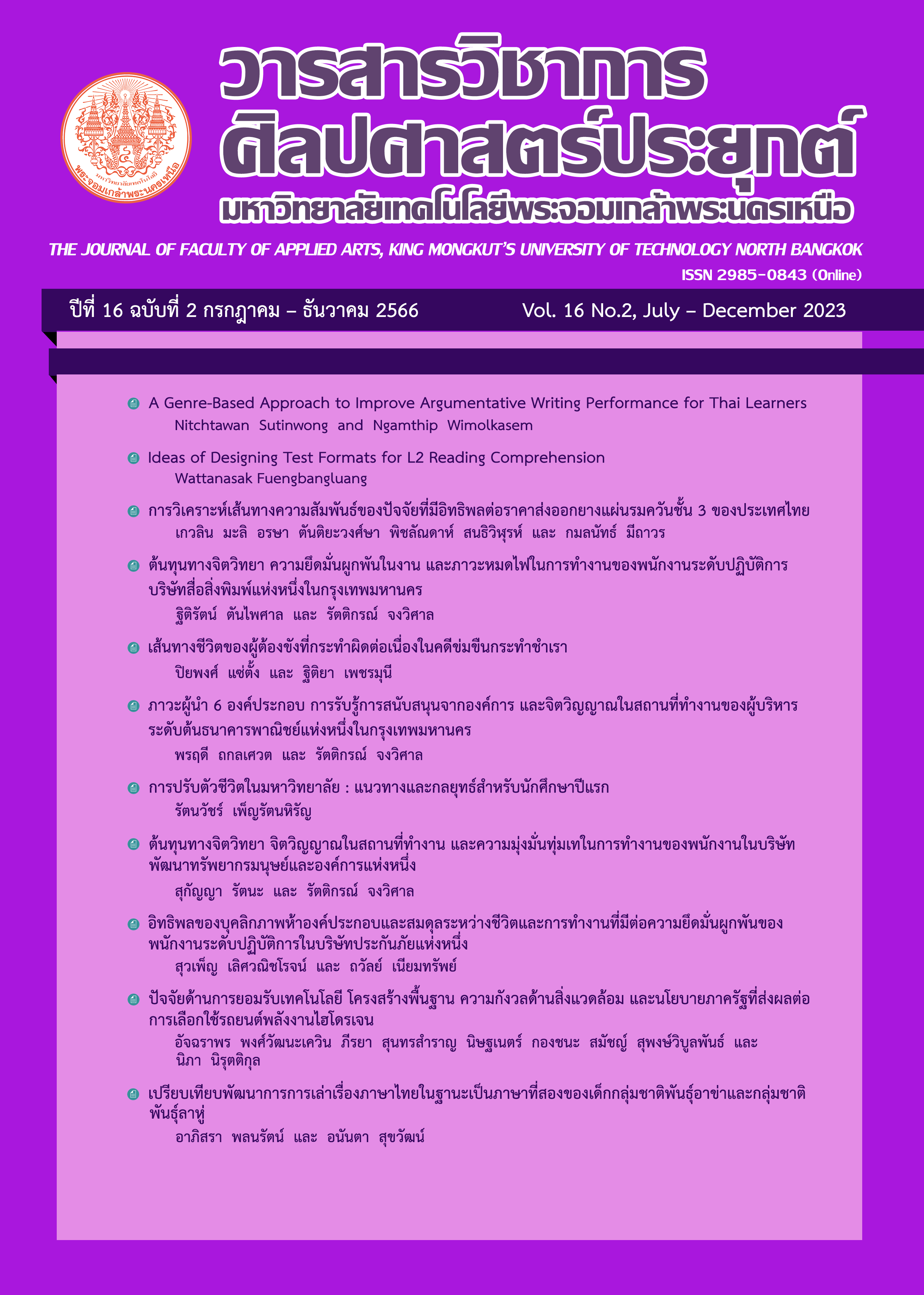แนวคิดการออกแบบทดสอบการอ่านภาษาที่สองเพื่อความเข้าใจ
Main Article Content
บทคัดย่อ
บทความวิชาการฉบับนี้มีวัตถุประสงค์เพื่อแนะนำแนวทางการออกแบบการประเมินความสามารถในการอ่านภาษาที่สอง มีการสืบค้นและทบทวนบทความวิจัยและวรรณกรรมเพื่อให้ภูมิหลังเกี่ยวกับการสอนการอ่านภาษาที่สองและการประเมินความสามารถในการอ่าน จากการอภิปราย พบว่า การอ่านภาษาที่สองควรเน้นย้ำตัวแปรที่เกี่ยวข้องกับทักษะการประมวลผลข้อมูลของผู้อ่านภาษาที่สองและแหล่งข้อมูลทางภาษาต่าง ๆ เพื่อส่งเสริมการอ่านเพื่อควาเข้าใจให้ดียิ่งขึ้น ทั้งนี้ แบบการประเมินความสามารถในการอ่านภาษาที่สองที่มีอยู่ทั่วไปยังสามารถนำมาประยุกต์ใช้ได้ ถึงอย่างไรก็ตาม ควรปรับให้สอดคล้องกับตัวแปรที่กล่าวไปข้างต้น ในบทความวิชาการนี้ ได้นำเสนอแนวทางการออกแบบการประเมินความสามารถในการอ่านภาษาที่สองซึ่งสามารถนำไปประยุกต์ใช้ในชั้นเรียนภาษาทั่วไป
Article Details

อนุญาตภายใต้เงื่อนไข Creative Commons Attribution-NonCommercial-NoDerivatives 4.0 International License.
1.บทความที่ตีพิมพ์เป็นลิขสิทธิ์ของวารสารวิชาการศิลปศาสตร์ประยุกต์ การนำเนื้อหา ข้อความหรือข้อคิดเห็น รูปภาพ ตาราง ของบทความไปจัดพิมพ์เผยแพร่ในรูปแบบ ต่าง ๆ เพื่อใช้ประโยชน์ในเชิงพาณิชย์ ต้องได้รับอนุญาตจากกองบรรณาธิการวารสารอย่างเป็นลายลักษณ์อักษร
2.ข้อความที่ปรากฏในบทความแต่ละเรื่อง เป็นความคิดเห็นส่วนตัวของผู้เขียนแต่ละท่านไม่เกี่ยวข้องกับวารสารวิชาการศิลปศาสตร์ประยุกต์ และบุคลากร คณาจารย์ท่านอื่น ๆ ในวารสารฯ แต่อย่างใด ความรับผิดชอบองค์ประกอบทั้งหมดของบทความแต่ละเรื่องเป็นของผู้เขียนแต่ละท่าน หากมีความผิดพลาดใด ๆ ผู้เขียนแต่ละท่านจะรับผิดชอบบทความของตนเองแต่ผู้เดียว
เอกสารอ้างอิง
Alderson. J. C. (2000). Assessing reading. Cambridge: Cambridge University Press.
Aukerman, M., Brown, R., Mokhtari, K., Valencia, S., & Palincsar, A. (2015). Examining the relative contributions of content knowledge and strategic processing to comprehension. Literacy Research: Theory, Method, and Practice, 64(1), 73-91.
Behney, J., & Gass, S. (2021). Interaction. Cambridge: Cambridge University Press.
Bernhardt, E. B. (2005). Progress and procrastination in second language reading. Annual Review of Applied Linguistics, 25, 133-150.
Bernhardt, E. B. (2005). Progress and procrastination in second language reading. Annual Review of Applied Linguistics, 25, 133-150.
Bernhardt, E. B. (2011). Understanding advanced second-language reading. London: Routledge.
Cai, Y., & Kunnan, A. J. (2019). Detecting the language thresholds of the effect of background knowledge on a Language for Specific Purposes reading performance: A case of the island ridge curve. Journal of English for Academic Purposes, 42, 100795.
Carrell, P. L., Devine, J., & Eskey, D. E. (1988). Interactive approaches to second language reading. Cambridge, England: Cambridge University Press.
Fuengbangluang, W., & Panjanon. V. (2022). The use of English reading strategies of Thai engineering undergraduate students for reading comprehension. The Liberal Arts Journal, Mahidol University,5(1), 27-57.
Gass, S. M. (2003). Input and interaction. The handbook of second language acquisition, 2, 224-256.
Grabe, W. (2002). Reading in a second language. In Kaplan, R. B. The Oxford Handbook of Applied Linguistics (pp. 60-72). Oxford: Oxford University Press.
Grabe, W. (2009). Reading in a second language: Moving from theory to practice. Cambridge: Cambridge University Press.
Grabe, W. P., & Stoller, F. L. (2013). Teaching and researching: Reading. London and New York: Routledge.
Gui, M., Chen, X., & Verspoor, M. (2021). The dynamics of reading development in L2 English for academic purposes. System, 100, 102546.
Guo, L. (2018). Modeling the relationship of metacognitive knowledge, L1 reading ability, L2 language proficiency and L2 reading. Reading in a Foreign Language, 30(2), 209-231.
Hedgcock, J., & Ferris, D. R. (2009). Teaching readers of English: Students, texts, and contexts (1st ed.). London: Routledge.
Jiang, N. (2018). Second language processing: An introduction. New York: Routledge.
Krashen, S. (1982a). Principles and practices in second language acquisition. Oxford: Pergamon.
Krashen, S. (1982b). The role of input (reading) and instruction in developing writing ability. Lenguas modernas, 9-10, 23-35.
Krashen, S. (1985). The input hypothesis: Issue and implications. London: Longman.
Krashen, S. (2003) Explorations in language acquisition and use. Portsmouth: Heine-mann.
Liao, R. J. (2021). Exploring task-completion processes in L2 reading assessments: Multiple-choice vs. short- answer questions. Reading in a Foreign Language, 33(2), 168-190.
Mikulecky, B. S. (2008). Teaching reading in a second language. Retrieved from http://www.longmanhomeusa.com/content/FINAL-LO%20RES-Mikulecky- Reading%20Monograph%20.pdf
Suh, Y. M. (2013). A focus group study on Korean college students’ awareness and applications of reading strategies. 현대영어교육, 14(2), 145-163.
Zhang, L. J. (2016). Teaching reading and viewing to L2 learners. In W. A. Renandya, & H. P. Widodo (Eds.). English language teaching today. Linking theory and practice (pp. 27–142). Springer International Publishing.


